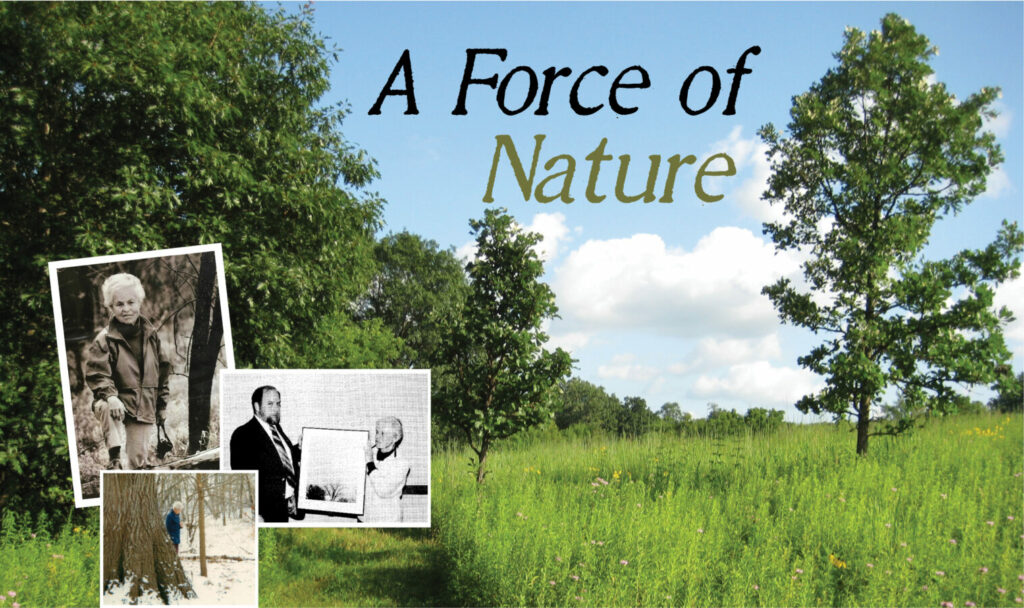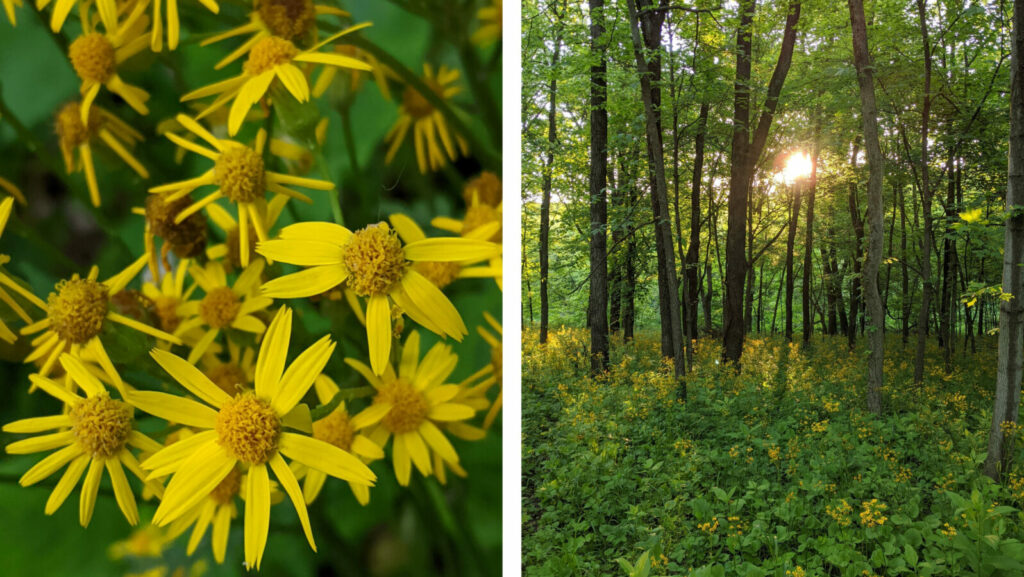A Force of Nature: How one woman’s mission to save land led to 45 years of conservation

When there was a chance to protect nature in Iowa City, Nancy Seiberling went for it.
Because of her determination, Bur Oak Land Trust is celebrating 45 years of conservation this year and taking a look back at how it all began.
“Her impassioned pursuit of goals for herself and the community set an example of what an older woman can accomplish,” said Nancy’s daughter Grace Seiberling.
In 1978, Nancy and a small group of ardent supporters formed Johnson County Heritage Trust, JCHT, because they saw a need to “protect land of significant environmental value from development, and to encourage responsible land management.”
As a self-described professional “civic volunteer,” Nancy was a fierce advocate for the environment. She was a transplant to the Iowa City-area in 1959, when her husband Franklin Seiberling Jr. became head of the Department of Art and Art History at the University of Iowa. The way Nancy’s friends and family tell it, she was energetic and influential when it came to her interests.
“I went on the JCHT Board initially because Nancy insisted that as a founder I must do so,” said Bill Hines, chair of the steering committee and former land trust board member, “One did not say no to Nancy. She was a force of nature.”
Grace said her mother’s love of nature started early as one of Nancy’s first memories was making a pretend garden. As a child, Nancy explored the outdoors and learned wilderness skills in Maine, Grace said, where she spent time with her grandparents at Philips Lake and along the shore in Searsport. When Grace was growing up, she said her mother shared that love of nature with her three children.
“She encouraged us to look,” she said, “frequently exclaiming at the beauty of something in nature.”
Nancy believed that places where wildflowers grew were magical and when those places lost their natural features, they also lost their essence. Her advocacy work began in a very different landscape after the Seiberling family moved to Iowa from Ohio. Nancy focused her attention on the urban environment, Grace said, starting the nonprofit Project GREEN (Grow to Reach Environmental Excellence Now), that enhanced public greenspaces and parks, and getting others involved in local zoning issues.

Nancy’s influence and connection to people was far-reaching. When they would go shopping around town, Grace said Nancy was “always greeted warmly by the business owners whom she’d persuaded to participate financially and had enlisted as supporters. She also had a group of admirers who had participated in various projects as teenagers, preparing bikeways, digging, or clearing brush, both engaging with the environment and having a sense of contributing to a larger good.”
One particular municipal issue that caught Nancy’s attention involved a piece of land near Hickory Hill Park. A 40-acre tract of open land that shared a boundary with the park was up for sale. Nancy saw an opportunity to add the area to expand the park and provide greater outdoor access to the public. She contacted Hines, whom she knew previously, to ask him how money could be raised to buy the land and donate it to the city. Hines suggested she approach larger conservation organizations in the state. Those organizations weren’t interested in the small parcel of land in Johnson County so they needed a new plan.
“I then suggested that we create our own land trust as a nonprofit and see if we could raise enough funds locally to make sure the land then at issue became part of Hickory Hill Park,” Hines said. “Nancy liked this idea and this agreement was the start of the Johnson County Heritage Trust. I drafted the legal papers, and filed them with the state, then Nancy and I invited some other folks active in the cause of environmental and historic preservation to join us on the JCHT Board and we were off and running.”
Articles of incorporation were filed May 3, 1978, and JCHT was officially founded. Unfortunately, the new land trust was too late. The land it was formed to preserve was sold the year prior.
“We were very disappointed in not being able to protect this valuable land, and we resolved to have a standby organization in place ready to tackle the next such opportunity to protect land that had high potential for public use,” Hines said. “That was the original purpose of JCHT, but it evolved over the years and when it became Bur Oak Land Trust, it was much more aggressive in identifying and protecting environmentally sensitive and historically significant tracts of land.”
The land trust was renamed in 2015, but still upholds its founding mission of protecting land of significance in addition to expanding biological diversity and helping more of the community get connected to the outdoors. The growth of the land trust is apparent by the number of acres it protects.
Through ownership and conservation easements, Bur Oak now protects more than 1,000 acres of land in eastern Iowa. Although a thousand acres is a small fraction of the number of acres that exist in Iowa, the state is one of the most altered landscapes in the country. Through land protection, plants and wildlife have suitable habitats to thrive. The land trust allows public access to most of the preserves for people to experience a more native environment.
Hines served as the first board president for several terms and continued to serve on the board as a director until 1996. Like Seiberling, Hines was not originally from Iowa, but brought an interest in nature with him when he moved to Iowa.
“I grew up on a Kansas farm and have always been an outdoors person,” he said, “fishing and hiking in natural environments.”
Before forming the land trust in 1978, Hines was teaching land use control and environmental law at the University of Iowa College of Law where he served as dean. Given his upbringing, Bill said it was predictable that his law career and scholarship focused on environmental issues. He is still at the college as the Joseph F. Rosenfield Professor and Dean Emeritus. Given his professional background, Hines’ role at the land trust was a natural fit.
“My favorite JCHT project was the acquisition of the Turkey Creek property, which was the first to be donated to JCHT in about 1980,” said Hines. “Iowa City families, who were active in Project GREEN, owned this land that they had purchased as an investment.”

As the families spent time on the land they discovered the features that made the area special and wanted to protect it from future development. Hines said that’s when the JCHT board expressed an interest in taking ownership of the 107 acres of grassland and timber of what is now Turkey Creek Nature Preserve. The families involved in the donation were Webster and Gloria Gelman, Gerald Howe, Charles and Barbara Buckley, the printmaker Mauricio Lasansky and his wife Emilia Lasansky.
“Turkey Creek remains one of the jewels in the [Bur Oak] crown.”
As the first, largest, and relatively untouched property under land trust control, Turkey Creek Nature Preserve required a lot of hands willing to pull up and cut down invasive plants like thistles, black locust, and buckthorn to return the land to a more native state and to make safer walking trails for the public.
“We also planted a prairie on about 20 acres of the upland area and tended it carefully with annual burnings,” Hines said. “Turkey Creek remains one of the jewels in the [Bur Oak] crown.”
After the land trust received the large land donation, the effort was declared “a major victory” in the local newspaper.
“Indeed, the Turkey Creek Wilderness Area is not only an investment in an environmentally sound future, but it also represents the start of what could be a fruitful partnership of public agencies and private interests working together toward environmental goals,” the editorial board of the Iowa City Press-Citizen wrote Nov. 19, 1980, “We hope that partnership succeeds.”
The land trust has expanded its list of partnerships, preserves and projects since then. Bur Oak owns 12 preserves, most of them in Johnson County and most of them open to the public year-round. The land trust also protects about 400 acres of land through conservation easements, or agreements with landowners to care for the land’s natural attributes. Of the total preserves, five of them include prairies.

The prairies at Turkey Creek Nature Preserve remain some of the most restored and well-loved prairies in land trust care, making them ideal locations to watch a mix of pollinators in their natural habitat including the endangered rusty patched bumble bee.
“[Nancy] was intrigued by the prairie, and took us places, like old Rochester Cemetery, where native plants survived,” Grace said. “She was delighted to discover native wildflowers growing on the hillside below the house on Black Springs Circle and said she wouldn’t have planted daffodils had she known, even though she enjoyed the daffodils.”
The trail to what Bur Oak Land Trust is today was not traveled alone. Along with Seiberling and Hines were seven additional founding board members: David A. Ferree, Betsy Hillman, Fremont Isaacs, Jean Lloyd-Jones, Louis Loria, Harold Stager and James B. Lindberg. This group firmly established the land trust. Since the first steering committee meeting, the land trust has had more than 80 additional members serve on the board, and countless volunteers and donors who have supported its conservation mission.
Nancy was once asked if she had to do it all over again, would she study landscape architecture instead.
“She said ‘no’, her real passion was working with people and getting them mobilized to take action,” Grace said.
She continued to say Nancy would be thrilled to know that the land trust she started has a greater mission, has protected more lands, and has gotten more young people involved in conservation through the AmeriCorps program.
The challenges the land trust faced at the start — habitat loss, the threat of development, climate change — still exist, but by looking back, the progress made against those obstacles over the years is clear. Esteemed biologist and conservationist Rachel Carson once wrote, “In nature nothing exists alone.” Nancy understood the power of getting people to work together to generate change. Bur Oak Land Trust has only grown in the last four decades because so many others believe as she did.
You can support our next 45 years of conservation by making a gift today!



